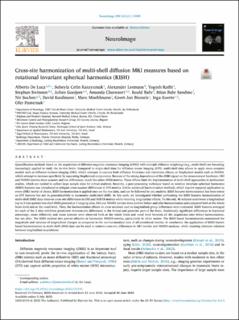| dc.description.abstract | Quantification methods based on the acquisition of diffusion magnetic resonance imaging (dMRI) with multiple diffusion weightings (e.g., multi-shell) are becoming increasingly applied to study the in-vivo brain. Compared to single-shell data for diffusion tensor imaging (DTI), multi-shell data allows to apply more complex models such as diffusion kurtosis imaging (DKI), which attempts to capture both diffusion hindrance and restriction effects, or biophysical models such as NODDI, which attempt to increase specificity by separating biophysical components. Because of the strong dependence of the dMRI signal on the measurement hardware, DKI and NODDI metrics show scanner and site differences, much like other dMRI metrics. These effects limit the implementation of multi-shell approaches in multicenter studies, which are needed to collect large sample sizes for robust analyses. Recently, a post-processing technique based on rotation invariant spherical harmonics (RISH) features was introduced to mitigate cross-scanner differences in DTI metrics. Unlike statistical harmonization methods, which require repeated application to every dMRI metric of choice, RISH harmonization is applied once on the raw data, and can be followed by any analysis. RISH features harmonization has been tested on DTI features but not its generalizability to harmonize multi-shell dMRI. In this work, we investigated whether performing the RISH features harmonization of multi-shell dMRI data removes cross-site differences in DKI and NODDI metrics while retaining longitudinal effects. To this end, 46 subjects underwent a longitudinal (up to 3 time points) two-shell dMRI protocol at 3 imaging sites. DKI and NODDI metrics were derived before and after harmonization and compared both at the whole brain level and at the voxel level. Then, the harmonization effects on cross-sectional and on longitudinal group differences were evaluated. RISH features averaged for each of the 3 sites exhibited prominent between-site differences in the frontal and posterior part of the brain. Statistically significant differences in fractional anisotropy, mean diffusivity and mean kurtosis were observed both at the whole brain and voxel level between all the acquisition sites before harmonization, but not after. The RISH method also proved effective to harmonize NODDI metrics, particularly in white matter. The RISH based harmonization maintained the magnitude and variance of longitudinal changes as compared to the non-harmonized data of all considered metrics. In conclusion, the application of RISH feature based harmonization to multi-shell dMRI data can be used to remove cross-site differences in DKI metrics and NODDI analyses, while retaining inherent relations between longitudinal acquisitions. | en_US |
